Games for development fine motor skills do it yourself
The relationship of fine motor skills and mental activity.
The formation of the child's verbal speech begins when the movements of the fingers reach sufficient accuracy. It has been established that in the human brain the centers responsible for speech and finger movements are located close, so speech reactions are directly dependent on the fitness of the fingers.
Conditions effective development fine motor skills.
All fingers of both hands must be used. Compression, stretching and relaxation movements must be combined. Exercises should be based on the use of isolated movements of each finger. For the successful development of fine motor skills, it is important to train both hands. It is important in games to equally develop subtle movements of the fingers of both hands, and in everyday life to strive to distribute various actions between the right and left hands.
The value of games for the development of fine motor skills.
Games and exercises for the development of fine motor skills are a powerful means of maintaining the tone and performance of the cerebral cortex, a means of interacting with the underlying structures. In their process, children improve attention, memory, auditory and visual perception, perseverance is brought up, playing and educational and practical activities are formed. Systematic exercises also help to develop the skills of self-control and self-regulation of hand movements not only under visual control, but also with the participation of touch, tactile-motor sensations.
Games that parents can make from scrap materials.
To strengthen and develop the child's hand, coordination of movements, various exercises and actions with objects are recommended:
1. Twistingribbons, threads, winding balls.
2. lacing. You will need a piece of linoleum with holes made and a lace, or ready-made forms with holes, tablets with pins. (game "Lacing").



3. Button fastening. You will need fabric, buttons and thread. (game "Clips").
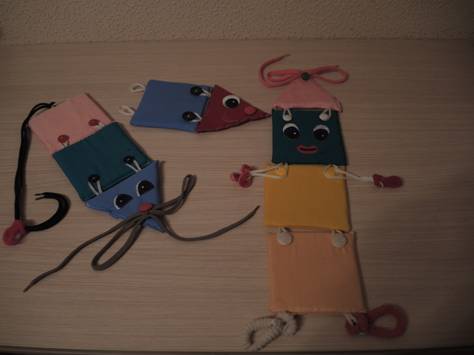

4. Laying out, sorting outseeds, beans, large seeds, curly pasta.

5. Clothespin games. You will need clothespins and cardboard, lids, rings.

6. Twisting and twistingcovers. You will need necks and caps from plastic bottles, a dense base (linoleum, cardboard), all kinds of jars with a threaded twist.

You can simultaneously teach children ordinal counting, orientation in color.
7. Guessing by touchitems. (game "Magic bag"). You will need a bag with a variety of small toys and objects or a “muffet” with a pocket at the bottom.
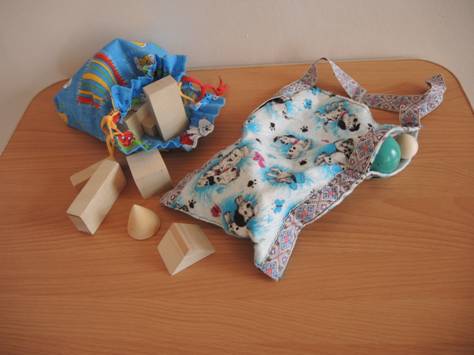
8. rollinga pencil or pen, a cone or a sensory ball with spikes in the palms helps to stimulate biologically active points, toning the body as a whole.
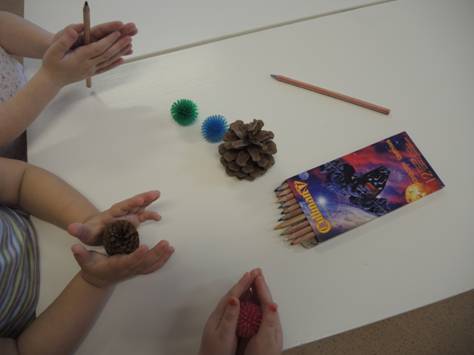
9. Stroke stencils, patterns, any shapes cut from plastic bottles or linoleum.
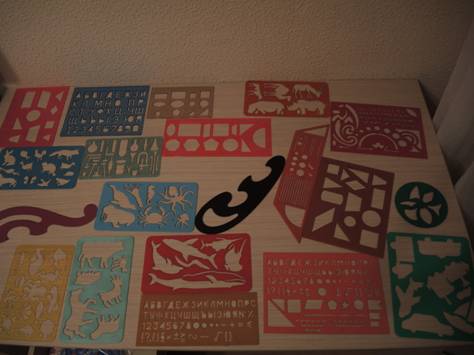
10. stringing beads, rings, buttons and any shape with holes.

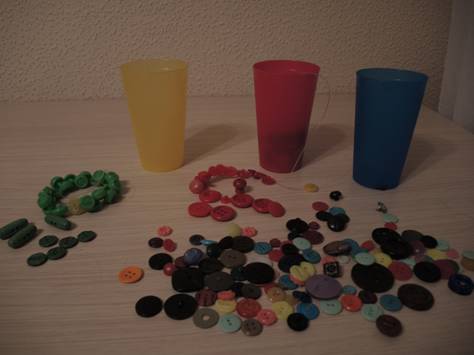
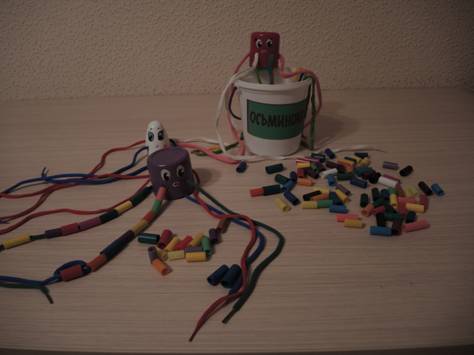
11. Posting picturesfrom geometric mosaic or sticks. (required geometric figures from plastic, cardboard, linoleum or ready-made magnetic figures, molds, matches without sulfur heads or counting sticks, cocktail tubes, tubes from used felt-tip pens, etc.)
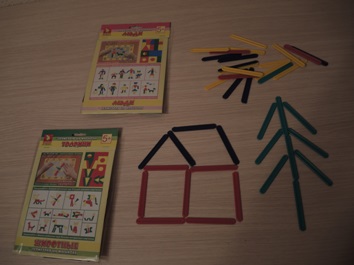
12. Laying out and picking out with tweezersbeads, buttons, pebbles, small figures, folding them into a container with a hole.
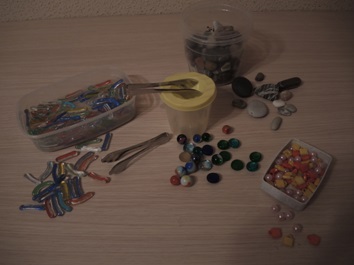
13. Braiding.
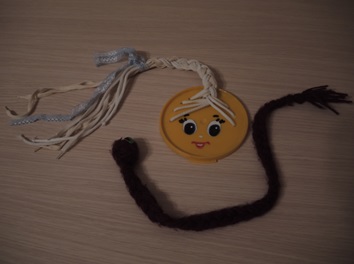
14. push throughsoft rough objects, pieces of fabric, ribbons into various holes and tunnels with your fingers.
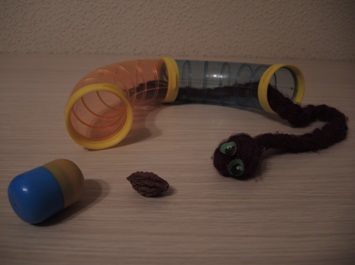
Each of these techniques is aimed at the development of the child: his musculoskeletal system, sensory sensitivity, hand-eye coordination, voluntary attention, psychoregulation skills.
"A child's mind is at their fingertips"
V. A. Sukhomlinsky

In this article I will describe small children. These 20 games are simple for an adult, but for children under 2-3 years old they are often difficult. And for kids up to a year, and even more so, they are a real puzzle.
Development of fine motor skills very important for the full development of the brain. Through action and games for the development of fine motor skills the child develops coordination of movements, learns to control his body, concentrate on objects. No one will give a 100% guarantee that only thanks to the constant stimulation of the fingers, the child will speak early or grow up to be a child prodigy. But the development of hand motor skills is one of the simple and effective developmental activities. This is especially important for children with a delay speech development.
20 games for the development of fine motor skills of hands
1. Perhaps the first thing parents can do for development of fine motor skills- This hand (and foot) massage. The newborn does not yet consciously act with his hands, but his palms feel everything.
I advise you to buy in a pharmacy massage balls complete with two metal rings. They can be called: su-jok massager, massage chestnut. This is a plastic ball with not very sharp spikes. Inside it is a special spring ring for finger massage. Such a massager costs about 20-30 rubles. It is rolled on the palms and feet, the ring is put on in turn on each finger and also rolled.

Su-jok massage ball with spring rings

Massage ball su-jok

spring ring massage
You can play the story with the child. “A hedgehog came running from the forest, ran along the palm, along the leg, and again ran into the forest.” Or “The chestnut fell from the tree. We will raise it. Oh prickly prickly. Let's roll it and put it back."
2.
Bags of cereals. This game is also available for very young children. It is necessary to make several small bags of dense fabric. We pour different cereals into them: buckwheat, peas, beans, millet. The main thing is that the bag does not tear. Under the supervision of an adult, such a bag is given to the baby. He feels it, rumples it. Different grains give different sensations.
With older children, you can already try to guess what kind of grains are inside.
3. Favorite by many finger games-fun. These games help to relieve the tone from the palms and are also accompanied by a light massage. Perhaps the most famous magpie game:
Magpie-magpie cooked porridge,
(cook - mix porridge on the palm of your hand)
She fed the kids.
I gave it, I gave it
(fingers are massaged separately)
I gave it, I gave it
And she didn't give it.
You didn't chop wood? Didn't prick.
Didn't you carry water? Did not wear.
We won't give you porridge.
4.
Bulk material games: cereals, grains, legumes, pasta, sand. There is a lot of room for imagination here. Groats can simply be poured into a deep bowl and let the child rummage through it, buy pens. You can mix different grains.

Grain game

Rice with beans
Give your child 2 bowls. Pour cereal into one, and leave the other empty. Give the child a spoon and offer to use the spoon to pour the cereal from one bowl to another.

Daughter plays with cereals
5. Playing with semolina or sand in the sandbox. Hide beans, buttons in semolina, small toys. And then ask the child to find. In the sandbox, you can also bury an object first, and then look for it. Only the sand must be dry and clean. Also in the river sand there are many pebbles and shells. Try collecting pebbles in a bucket on the playground, and then laying out a picture of them in the sand.

The daughter always brings the collected stones home for the collection :)

This is how my daughter played with semolina instead of sand in winter
6. Variant of the game with decoy - draw with a finger. Pour a layer of semolina on a tray and try to draw something with your finger. To begin with, the mother leads the baby by hand and draws simple drawings: shapes, wavy and straight lines. Then the child himself tries his hand.
7. Did you give your baby play with cones? We collected a whole package of pine cones from the forest. I dried them out and gave them to my daughter to play with. The effect is similar to the su-jok massager from the first paragraph. It is especially interesting to play on the theme of a rhyme about a bear:
bear clumsy
Walks through the forest.
collects cones,
Sings songs.
The bump bounced
Directly to the bear in the forehead.
Teddy bear got angry
And with the foot - top!
Give the child a basket or bucket and let him collect the cones scattered on the floor.
eight . A useful activity that strengthens the fingers is pressing different buttons. Various musical toys and books with buttons will help here.

Musical toy with buttons
9. Even bird feeding on the street develops children's fingers. Children love to crumble bread, sprinkle crumbs, seeds or grains. Use it. Take seeds or millet for a walk. After do not forget to wipe your hands, because. they have dirt or grime on them.

We feed the pigeons

We feed the pigeons
If you don’t go for a walk because of bad weather or illness, then there is a way out. Draw birds (hens, chicks, pigeons) on paper or find pictures. Put the picture of the bird on the table or on the floor and invite the child to feed it. Let the baby also sprinkle grains and seeds. And then the bird will say thank you and fly away.
10. Various laces are useful toys. It can be an apple, a pear, a berry with a worm on a thread, a large wooden button, etc. The ability to get into a small hole also needs to be developed.

Lacing “Pear”

Lacing “Button”
11. Stringing beads close to the lacing activity. Ready-made educational games are sold for children. Or you can just take pasta with large holes. Instead of thread, use thick wire.

wooden beads

Pasta beads
12. I like games with clothespins. my daughter. True, her fingers are still weak. But for some clothespins, there is enough strength. She is interested in how things are attached to a rope. You can put a low clothes dryer on the floor or tie a thick rope between the chairs, and then hang handkerchiefs and doll clothes with clothespins. My daughter especially loves taking pictures of this.

Favorite clothespins
13. Do you think children love tear and crumple paper? It's the first thing they do to her. My child has an incredible urge to tear a paper napkin or a paper handkerchief into tiny pieces. And then she collects them and throws them in the trash can. And several cosmetics catalogs suffered from her research interest. Be careful. Paint from glossy magazines and newspapers is easily erased, it should not fall into the child's mouth. Therefore, let him vomit, but just do not pull in his mouth. After such a lesson, the hands should be washed. And it is better to give a blank sheet, for example, from a notebook. Or give a small notebook to tear to pieces.

Children love tearing and crumpling paper.
14. Drawing with pencils, chalk, brush, finger paints It also develops fine motor skills of the hands. Just try to immediately teach how to hold a pencil correctly. My daughter liked to draw with water-based markers on a magnetic board. The drawing is then easily erased with a sponge, and this skill will also come in handy. We also like to draw with wax and oil pencils (they are also called wax crayons, oil pastel). They do not need to be pressed as hard as wooden pencils and the colors are bright. And how a child may like the process of folding pencils, crayons into a box and taking them out of it. Check it out yourself.
My daughter didn't like the finger paints. She does not like to get her hands dirty, she wants to wipe them right away.
15. Modeling. It has already been mentioned more than once in my articles. With children, you can sculpt from plasticine, salt dough. Salt dough is more suitable for the first acquaintance with modeling. It is softer and safer than plasticine. You can cook it at home (), or you can buy ready-made. The first thing we show the child is how the dough wrinkles, changes shape, how to pinch off a piece, roll up a sausage, stick various little things into it.

Salt dough figurines. Guess what phrase is shown here?
As the first crafts, there can be simple applications. See an example of such an application.
With a child over 1.5 years old, try making a hedgehog. Form the body of a hedgehog from plasticine. Take matches and show your child how to make needles. Let the kid try too.

Hedgehog made of plasticine and matches
16. Playing with a matryoshka is also developing. In addition, it will visually introduce the concepts of big-small, more-less. And the baby will have to make an effort to get to those pupae that are inside. And it is very desirable to do so.
17. When the child grows up, they begin to teach him to dress, to fasten on his own. It is too useful activity for development of fine motor skills. How many possibilities: buttons, zippers, Velcro, buttons, laces, belts. My daughter had a strong interest in all kinds of fasteners at the age of 1 year 9 months. As soon as I put on a dressing gown, she will certainly try to unbutton it, fasten it. I even started unbuttoning my dad's jacket first thing when he comes home. She took my belt away and wouldn't let me zip up her boots. In general, the old dressing gown with large buttons was given to be torn to pieces. As a result, in 3 days my daughter mastered the buttons.

Mastering buttons
18.
An interesting game on the development of fine motor skills will be taking items out of a bag. First, the child feels the object and tries to understand what it is. And then he sees him. So you can introduce new things or guess already known ones.
19. Catching objects from the water. Try this game. Pour some water into a basin or deep bowl and throw in chestnut kernels, hazelnuts, wine corks or table tennis balls. Give the child a strainer or a spoon, depending on the size of the objects and skill. The task of the baby is to catch all the items and put them in another plate. Help the child first. Then let him try it himself.
20. Well, in the end, such an activity as harvesting in a country house or garden, also contributes well development of fine motor skills. Show your child how to pick tomatoes, how to strip a corncob, how to get beans out of a pod. Ask to shift the onions, cucumbers from one bucket to another (at home we don’t sort onions without our daughter, she loves this activity very much). Scatter dill seeds with your baby in the garden. Let the child try to pull out a carrot, beet or onion from the garden. You can try to pick berries, but there is a risk that they will be crushed. To train the skill of picking berries, you can play the game at home.

The pods are dry, you can get the beans

Helps harvest
Here is such a list games for the development of fine motor skills turned out. But that is not all. A lot of everyday activities are perceived by the child as a game and perfectly develop it. Therefore, you should not be limited to special games and toys. Involve your child in what you are doing. This will allow you to do things, and entertain the child, and teach what you yourself know how.

Cooking chestnut soup
I wish your children happy childhood. Come back to the site. It will be interesting.
Development of fine motor skills! How many articles and publications have been written about her! As soon as a child is born, all experts unanimously repeat that it is necessary to take care of the child, Special attention giving hand motility! In this article, I decided not to repeat myself, talking about the usefulness of this lesson, but simply to bring an assortment of games that develop the motor skills of the baby's fingers.
35 games for the development of fine motor skills
1. Give your child disposable cocktail sticks and ask them to stick them into the holes in the colander.
2. The game is very similar to the previous one! The only difference is that instead of cocktail sticks, you will give your child ear sticks. Children like to fill all the holes in the colander with ear sticks. Great game for developing fine motor skills.
3. One more exciting game for fine motor skills: the distribution of colored pompoms in the cells of a baking dish. This game is for kids who learn the names of colors and know their difference.
You give the kid a lot of multi-colored pompoms, and he puts them into cells, sorting them by color.
4. To play you will need:
- egg container
- cocktail sticks (preferably multi-colored)
- toilet paper rolls, cut into rings.
Poke holes in each egg cell. Have your toddler insert cocktail sticks into them and then put on rings cut from toilet paper rolls.
5. Prepare everything you need for this game! Stick a ball of plasticine on the modeling board, stick a barbecue stick or skewer into it. Have the baby put the cookie rings on her as shown in the picture.
6. The game is very similar to the previous game, only a cocktail tube is attached to a lump of plasticine and the kid strings raw pasta on it.
7. An outdoor game that will help your child learn color, develop attention, coordination and motor skills!
With multi-colored crayons, draw circles on the asphalt and ask the baby to stand in a circle of the color you named.
8. Give the little one plastic bottle and ask her to fill it with colorful pompoms, pieces of fluffy wire, colored ribbons, etc.
9. In an upright position a short distance from the floor, attach or glue a paper towel tube to the wall. Place an empty container or container underneath. The game consists in the fact that the baby will fill the container by throwing pompoms into the pipe.
10. The game consists in the fact that the child will take cubes with culinary tongs and throw them into a plastic jar or container
11. Another variant of the game is to sprinkle multi-colored pompoms on a tray, and then ask the baby to collect them in a container.
12. Children really like to play with water, so I suggest organizing a water game.
Place two containers, pour water into one of them.
Give the child a medical pear, and let it pour water from one container to another.
13. In preparation for this game, the baby will take an active part! Give the young artist paints and a brush to color the containers to play with. When the paint is dry, cut holes in the lids in the form of a small and large rectangle. The container, where the child will fill the hole with a smaller rectangle with ice cream sticks, and the container with a large rectangle, will fill it with lemonade or juice lids.
14. Attention! During the game, the baby can get dirty in the paint! The essence of the game is that young artist will dip a washcloth in multi-colored paints and make prints on paper or cardboard.
15. The game "Stringing on a rope"
Cut a cardboard tube from under toilet paper or paper towels into cylinders of the same length. Color them in different colors. The child should also take part in the coloring process.
Then give the baby a rope and ask him to string multi-colored cylinders on it. You name the sequence of colors or the child decides!
16. Another game where the kid can learn how to string pieces on a rope! To do this, cut shapes in the form of coils from foam rubber and ask the baby to string them on a rope.
17. The game will even please six months old baby. In the presence of an adult, the baby takes multi-colored pompoms, bottle caps, large buttons from a plate or tray and throws them into the container through the hole in the lid.
18. The baby inserts pieces of colored fleecy wire into the hole of an empty hodgepodge. Thus, fine motor skills of the hands develop.
19. Teach your child to pinch clothespins! To do this, take a bucket and the baby will pinch clothespins to its upper edge.
20. We teach the baby to use lightning. To do this, glue a few multi-colored zippers to the cardboard and show your little one how to unzip and fasten the zipper correctly.
21. The game is that the baby puts colorful plastic eggs in the egg container. Thus, he learns colors and develops hand motor skills! You can take these testicles from Kinder Surprise.
22. A game during which the baby learns colors, as well as learn how to fasten clothespins.
Color a sheet of cardboard in multi-colored stripes. Then, paint the clothespins in the same colors. When the paint is dry, have your child pinch the clothespin to match the color of the stripe.
23. A kid learns to put a button in a hole. For this game, cut multi-colored fabrics into small pieces, make an incision in the middle. Have your child thread the button through the hole.
24. The game "We string buttons on a string"! To do this, take a large number of large buttons and teach the baby to string them on a string.
25. The game "We thread the thread into the holes of the canvas"
Give the child a thread or thin cord and show how to thread it through the large holes in the fabric.
26. The game "We wrap objects or toys in foil"
To do this, give your child foil and ask them to wrap a toy or object in it! For example, show how to do it right!
27. Playing with colorful feathers.
Apps 2
Didactic games "Development of fine motor skills of hands"
"Pears and Apples with a Button"
Target: to exercise children in reinforcing the concepts of “big - small pear”, to teach to fasten and unfasten pears, apples, where the child reinforces the concepts of “one”, “many”, the development of fine motor skills of hands.
Equipment: pictures of apples, pears, threads, buttons, cardboard for tree layout, adhesive tape for "lamination".
Game progress: Let's play "Hurricane" - blowing on a tree and swinging it with one hand, the teacher or child unfastens an apple from it. "Bang! The wind blew the apple away and it fell to the ground. They offer the child to be the wind - to blow, shake the tree, then unfasten the apples.
Didactic game: "Feed the bun"
Purpose: development of fine motor skills and tactile sensitivity.
Equipment: low plastic jars with lids, cereals (beans, peas, buckwheat and others).
Game progress: the teacher tells the children that our Kolobok is hungry and needs to be fed. Children take cereal from a jar and put it in the mouth opening.
Didactic game "Grains-notions!"
Purpose: strengthening and development of fine motor skills of the hands, hand-eye coordination; the formation of the ability to combine by color (when using various cereals).
Equipment: different kinds cereals (beans, rice, millet and others).
Game progress: First, it is necessary to pour millet on a tray in an even layer (other cereals are also possible), and then, using red beans (this way the contrasting color stands out better), they come up with and impose different patterns, pictures.
"Paint a picture with corks"
Purpose: to develop the imagination, creativity of children, fine motor skills of hands.
Equipment: illustrations depicting flowers, an airplane, a Christmas tree, a fly agaric, a cork or a button.
Game progress: the teacher asks to finish the picture using corks or buttons.
"Colorful clothespins"
Purpose: to develop fine motor skills, imagination. Expand knowledge about the world around us, Exercise children in the ability to count and count, consolidate knowledge about color. Learn to take and open clothespins correctly, find the location by color. Cultivate an emotional attitude to the results of their work, perseverance, patience.
Equipment: planar image of objects (sun, plane, caterpillar, fish, turnip, beetroot, pineapple, house, hedgehog and others), clothespins.
Game progress: The teacher draws the attention of the children that the artist painted objects, but forgot to draw some details. Invite the children to help the artist and use clothespins to finish the picture.
"Colorful balls"
Goal: development of fine motor skills of the hands, fixing the primary colors.
Equipment: white and silver cardboard, basic color markers, glue stick, colored cardboard balls, laminating tape, pictures fairytale heroes, Velcro.
Game progress: the teacher asks the children to attach the balls in colors.
Exercise "Funny pencils"
Purpose: improving hand coordination, developing finger mobility, fine motor skills.
Equipment: multi-colored pencils, kinders, eyes.
Course of the exercise: The child rolls a pencil between his palms, fingers, saying: “I roll the pencil in my hands, I twist it between my fingers.
I will certainly teach each finger to be obedient.
"Palm - freeze!"
Target:development of statistical coordination of finger movements, exercise in holding a pose.
Instruction:stretch your arms forward with fingers apart and try to hold for 10 seconds. If you manage to hold the pose, then put your hands on the table. The teacher can lightly put the palms on the child's hands.
"Hi Bye!"
Target:training in flexion and extension of all fingers together and alternately.
Instruction:children bend their elbows, hold their hands in front of their faces, bend and unbend their fingers at the same time, without squeezing them into fists. Then they bend and unbend in turn, starting with the thumb.
10. "Journey of fingers"
Target:development and training of coordination of finger movements, development of fingertips, development of attention.
Material: a sheet of paper on which 2 houses are depicted at different ends of the "island" for moving fingers.
Game progress:the child sets his fingers near the first house. Then he begins to move with his fingers along the islets to another house, without taking his fingers off the other “bump”.
Rules:
you can move around, for starters, using 2 fingers;
all fingers must participate;
you can not tear off the first finger without rearranging the other.
"Treasure"
Target: development and training of coordination of finger movements, development of fingertips, color matching, development of attention.
Material: Figure 1 (see below)
Game progress:go over the bumps strictly on the map, which is located above the chest.
Rule:
all fingers are involved;
do not take the first finger off the bump until the other finger crosses.
"Good luck!"
Target:development of dynamic coordination, alternation of hand movements.
Game progress:(played by 2-10 people) during the game, children build a column from their hands, producing various generally accepted combinations.
For example, fist - fist - palm.
Rule:You can't be wrong. The hand that made the mistake is removed.
12. "Bunny and a mirror"
Target:improvement of coordination, automation and smoothness of switching.
Instruction: left palm up, we make a "goat". We put the right hand on top of it, which also depicts a “goat” (back side up). We expose up and down the middle and ring fingers of both hands and move them in opposite directions.
13. Birdhouse
Target:palm exercise.
Instruction:palms folded together, fingers pointing up, elbows in different sides. Then, without opening the palms and not lowering the elbows, they lower the hands down, bending the wrists.
14. "Chair"
Target:development of dynamic coordination, alternation of movement.
Instruction:left palm vertically up. A fist is attracted to its lower part (thumb towards you). If the child easily performs this exercise, you can change the position of the hands alternately at the expense of times.
15. "Table"
Target:development of dynamic coordination, alternation of movements, development of switchability.
Instruction:left hand in fist. The palm rests on top of the fist. If the child easily performs this exercise, you can change the position of the hands: the right hand is in the fist, the left palm is on top of the fist. You can do it alternately at the expense of times.
16. "Drummer"
Target:development of the skill of voluntary movements with the rejection of motor stereotypes.
Instruction:beating one bar at a time with the right (left) hand, simultaneously with the beat, we beat with the right hand, hit the table with the index finger of the left hand.
17. "Complicated Drummer"
Target:development of the skill of voluntary movements with the rejection of motor stereotypes, holding the posture.
Instruction:put your right (left) hand in front of you with fingers apart, place forefinger to the nameless or middle to the index (or vice versa) and lightly tap the tempo.
18. "Pliers"
Target:activation and preparation of the fingers for working with objects (pen, pencil, scissors).
Instruction:the child clamps the edges of the table between straight fingers (squeeze as hard as possible). The exercise is performed several times.
19. "Even-Odd"
Target:development of the ability to spatial orientation on paper; fostering an emotional, positive attitude to the game.
Material:2 pens of different colors, checkered sheet.
Game progress:a border is marked on one edge and on the other. The distance is chosen by the players arbitrarily. Players must move in turn, marking a line (straight, diagonal cells) from the end to the next end of the cell and so on. The winner is the one who reaches the border first (indirect borders).
The development of fine motor skills of the hands affects the intelligence of the baby, his memory, attention and thinking. Therefore, every mother strives to start exercising with the baby as early as possible. Many parents think that only specialists in development centers can conduct such classes. Of course, you can take the baby to classes in groups, but it’s easy to study at home, having developed a system and lesson plan that will be of interest to the child at an early and preschool age and are aimed at developing motor activity.
What is fine motor skills
Fine motor skills are coordinated actions of the hands and fingers that are performed in conjunction with the nervous, bone, visual and muscular systems. In other words, this is the ability to manipulate small objects, in which only the small muscles of the body are involved.
Do not confuse the concepts of fine and gross motor skills, sensory. They are interconnected, develop in the child's body in parallel, but differ from each other:
- gross motor skills are the movements of the large muscles of the body, the basis physical development child: walking, jumping, turning the body, running and other active actions;
- sensorics- this is the perception of the surrounding world through sensations (tactile, visual, gustatory, auditory), thanks to which the child develops skills and preferences, he has an idea about various objects, phenomena and actions.

Scientists have proven that the development of the hand is closely related to the development of speech and thinking of the child, so fine motor skills must be practiced from the very birth of the baby.
The mind of a child is at his fingertips.
V. A. Sukhomlinsky, teacher
This is not just a phrase, but a scientifically proven fact. It is at the fingertips that a huge number of nerve endings are located, through which impulses are fed to the brain, where information is processed, supplemented by data from various receptors: visual, auditory, olfactory. And only then the child perceives the whole picture, object or action. Teachers, together with famous scientists, have proved that by developing fine motor skills, the baby learns to speak, write, and think logically faster. Therefore, it is recommended to deal with it with early age.
Fine motor skills for the development of speech and other skills
- The ability to control hands is the basis for mastering the skills that a child needs in everyday life.
- Fine motor skills are needed for the development of the most important mental processes: memory, perception of the world around us, thinking, logic, attention and speech.
- The level of development of fine motor skills is one of the main indicators of a child's readiness for schooling.
Fine motor skills begin to develop from birth: first, the baby examines his hands, then learns to squeeze and unclench his fingers, control them in order to grab a toy or a nearby object. As he grows older, he understands how to hold a brush or pencil correctly, learns to draw, and closer to 6-7 years old he tries to write. Of course, the child will be able to study some points on his own, because all children are inquisitive and show interest in unfamiliar objects. However, scientists and teachers insist that parents engage with them through special toys and tasks, perform exercises that help improve fine motor skills of the hands.
The development of intellectual and thought processes begins with the development of the movement of the arms, fingers and hands - this is a fact proven by scientists. Therefore, in order for the child's brain to develop, it is necessary to train his hands. In addition, all future life will require the coordinated movements needed to draw, write, and perform many other activities.

Improving fine motor skills develops the child's brain and prepares it for everyday activities.
The lack of development of fine motor skills can lead to such consequences for the baby:
- lack of interest in drawing, modeling and other activities;
- difficulty adapting to educational process at school: the child perceives worse new material, does not read well, so the pace of learning seems to him too fast and difficult;
- underdevelopment creativity, thinking and attention;
- inability to draw a straight line evenly, to remember and write numbers or letters correctly;
- if you ask him to draw a picture, in most cases he cannot correctly place objects on the sheet space, he lacks imagination, there is no variety of colors and a clear plot;
- such children begin to speak later, many have speech defects that are difficult to correct even during classes with specialists.
What affects fine motor skills - video
Ways to develop fine motor skills relevant for children of different ages
In order for the child to develop harmoniously, it is imperative to deal with him from birth, I improve fine motor skills of the hands. Today, there are many authoring techniques, developing toys and activities that are held in game form and help to know new information through tactile sensations. Depending on the age and preferences of the baby, you can offer him:
- massage of the hands and fingers;
- games with cereals, beads, buttons, pebbles;
- finger gymnastics;
- graphic exercises, hatching;
- modeling from plasticine;
- collection of constructors and mosaics;
- drawing and coloring;
- cutting with scissors;
- paper work, origami folding, appliqué;
- rope games, lacing.
The importance of developing fine motor skills from an early age
The development of fine motor skills in children up to a year
Mom and dad can help their baby develop from birth. For children of the first year of life, such activities are suitable:
- massage of arms and legs;
- Finger paint.
Hand massage and massagers
Children up to a year are very useful massage of hands, fingers and legs. Parents can do it at any time of the day with no time limits. The main rule: the baby should like the exercises. If the baby feels discomfort, begins to act up and remove the arms or legs, it is better to postpone classes for a while.
- Gently sip the baby's fingers: the exercise should be slow and gentle, no sudden movements. Then each finger needs to be stroked. These actions can be carried out with children from two months and older.
- Make circular movements of the fingers in one direction, then in the other. The exercise is done with each finger separately.
- From 5 months, you can easily massage each finger of the child, then the palm and smoothly move to the hand. In addition to the development of fine motor skills, there is a general strengthening of the muscles of the upper limbs of the baby.
- At 8 months, it's time to connect more active exercises: tap your finger on the baby's palm, lightly press, bend and unbend your fingers. These actions can be done simultaneously with the pronunciation of the rhymes "Forty-white-sided", "There was a horned goat." The same is repeated with the legs of the crumbs.
It is very useful to use special simulators or massagers. They come in the form of a soft ball with an uneven surface, a roller or a ring that is worn on the finger. And you can use improvised materials: roll a walnut in your hands, sew bags from natural fabrics and pour different cereals into them. Give them periodically to the child in the hands - this is an excellent massage and stimulation of nerve endings.
You can perform exercises with a massager in different ways by rolling it:
- on the table;
- between palms;
- from fingertips to elbow;
- on the back of the hand.
The main thing to remember is that you need to deal with both upper limbs in turn. Some parents mistakenly believe that if they only pay attention to the right, their child will not be left-handed. This is an incorrect statement. For the harmonious development of the crumbs, two hands should be developed equally.
Exercise machines and massagers for the development of fine motor skills of hands - photo gallery
A walnut can be used to massage the hands. A ball-shaped hand massager. This finger trainer can be used when the child has learned to sit. Massagers can be different kind and forms
Children love to draw. You should not think that it is impossible to accustom them to creativity before 1–1.5 years, when they can take a brush or pencil from their hands. Today, finger paints made from natural ingredients and safe even if swallowed are very popular. Hand drawing is an ideal option for developing fine motor skills in infants. The child not only feels all movements with his fingers, but also perceives the colors of paints, learns to recognize them. In this case, sensory thinking also develops.

Finger painting promotes fine motor skills
We draw with finger paints - video
Topical methods for the development of motor skills in children from 1 to 2 years
At one year old, the child sits confidently, and perhaps already walks. Now he is more interested in educational toys, books and other objects around him. At this age, sensory perception is important for him, so you can connect the following activities:
- finger games, hand and hand massage;
- finger paints, gouache painting with a brush (children begin to paint with watercolors from the age of three);
- modeling: it is still difficult for small children to sculpt from plasticine, therefore the best way- dough;
- sorters and pyramids, soft puzzles - all this remarkably develops fine motor skills;
- bodyboards, games with lids - here the interest of the child and the scope of the imagination of the parents are important.
Toys and activities for young children - photo gallery
Modeling dough is softer than plasticine, so it is more suitable for children aged 1-2 years. With the help of a pyramid, you can work out coordination of movements. The sorter develops fine motor skills perfectly. With plastic covers, you can come up with a wide variety of games.
Educational games for children 1–2 years old - video
Tasks for kids 2-3 years old
At 2–3 years old, a child learns and masters skills very quickly. Children can already explain what they want to do, what they are interested in this moment. At this age, the development of fine motor skills contributes primarily to the development of speech. The kid pronounces more and more new words every day, learns to perceive and copy sounds, begins to speak in whole sentences, so it is extremely important to deal with him during this period. Classes do not radically differ from those that the baby was fond of in 1-2 years. But they can be complicated and new ones added:
- stringing: invite the child to collect beautiful beads for mom, or distribute shapes of the same color on a string;
- lacing games are very popular with children of this age;
- building a tower: the baby learns to coordinate movements, distributes the cubes evenly so that they do not fall;
- modeling plasticine crafts: this modeling material is more complex than dough, and the child needs to make more effort to work with it;
- classes with cereals: invite the baby to choose one cereal from the container and leave another in it;
- games with water: a child from a container with a spoon or net catches various objects.
Games with cereals, water, plasticine, cubes and other activities for children 2–3 years old - photo gallery
Building with cubes develops coordination of movements The kid is interested in correctly lacing up a model of a boot or fastening buttons on a doll’s coat Stringing develops logic and patience Modeling from plasticine is a more difficult task than modeling from dough Water games captivate children of different ages
Games for the development of fine motor skills for children 2-3 years old - video
Development of fine motor skills with children of kindergarten age (4-5 years)
At 4-5 years old, the child prefers to perform many tasks only on his own. He is interested in how the development board works, why the wheels are spinning and much more. Curiosity and craving for new knowledge only contribute to the harmonious development of the individual. The kid already has a good command of the brush and pencil, so the main tasks are aimed at preparing the hand for writing. Many parents think it's early for this age. Do not be confused, at 4 years old no one forces the baby to write whole words or letters if he does not show interest. To the exercises and activities described above, it is worth connecting new ones:
- sand games, or sand therapy, as psychologists often call these exercises: let the child run his fingers along the sand, drawing pictures or objects;
- working with scissors: first, the child learns to cut out even stripes, then geometric shapes;
- application: the kid will learn how to create compositions on a paper plane, work with glue and a napkin;
- drawing, coloring small details, shading - these skills prepare the baby's hand for writing.
Drawing, applique, hatching and other activities for a child 4–5 years old - photo gallery
At the age of 4-5 years, get special children's scissors with round edges. Applications will teach the child to be neat. Sand games are soothing to the child and are very useful for developing motor skills.
Exercises for the development of fine motor skills in children 4-5 years old
Fine motor skills for preschoolers 6-7 years old
At 6–7 years old, the child goes to school, so he must be mentally and intellectually prepared for a new stage in his life. Lessons provide discipline, quick capture and understanding of new material, the ability to memorize and repeat tasks well. At this age, all exercises are aimed at developing speech and writing, reading skills. That is why parents should pay special attention to improving fine motor skills. Insufficient development in this area leads in most cases to learning problems: the child cannot write or does it very slowly, his creative skills, imagination and thinking are poorly developed.
The following activities will help prepare your child for school:
- physical exercises: finger gymnastics, hand massagers, finger games, finger theater;
- mosaic: small details that need to be correctly assembled according to the instructions are a great way to develop little fingers;
- constructor: at this age, the large cubes familiar to the baby are replaced with smaller parts, with the help of which not only fine motor skills develop, but also imagination;
- copybook: you can circle not only letters or numbers, but also various shapes that may interest the child.
Motor skills classes for preschoolers - photo gallery
Collecting a mosaic according to the model will help in improving the fine motor skills of the preschooler's hands Constructors from small parts are very captivating for preschoolers Finger theater helps to strengthen the muscles of the hand and fingers
On the importance of developing fine motor skills in preschool children - video
How to develop fine motor skills in left-handed children and toddlers and visual impairment
Studies conducted by scientists have shown that many left-handed children have problems with the development of speech, writing and reading, so it is very important to do exercises with them to develop fine motor skills. Parents of a child who actively uses his left hand, and not his right, during classes, you need to take into account some of the nuances.
- The light source during the exercise should be on the right side.
- Left-handed children do not visually perceive the space that is to their left, so all objects must be placed to the right.
- Classes should be held with breaks. For a left-handed child, this is important, he needs more rest, so try to plan your exercises so that you have a break every 20 minutes.
- While writing, the child often pushes the left shoulder forward - this is the norm for children who hold the pen in their left hand, you should not specifically change his position.
- The main thing is not to focus on the fact that the baby is somehow different from other children. He should feel the support of parents and teachers.

Children with a dominant left hand often have difficulty mastering speech, reading and writing, so the development of fine motor skills is especially necessary for them.
Today, preschoolers are often diagnosed with visual problems. There can be many reasons why a child does not see well, but such children should develop on a par with their peers. Very often they cannot perform actions with their hands, they do not understand what to do. That is why they need to develop fine motor skills from an early age. However, it is better to start exercises from the age of two: the baby will already understand what you want from him, and will not be afraid.
- Mandatory massage and finger gymnastics: tapping, stroking, playing with massagers - all this should be in the training program.
- All classes are aimed at the study of information thanks to tactile sensations, so the child is offered items from different materials, different forms, which he touches, remembers and tries to describe his feelings.
- Visually impaired children learn to read in relief-dot cipher, so parents prepare the baby for the perception and understanding of this form: you can use foil on which lines, waves, dots and other shapes are drawn. He circles the raised drawings with his fingers, trying to understand and remember them.
- At an older age, a child can draw figures or drawings himself, and then read them by touch, as it were.
Do not think that if a child has poor eyesight or there is a delay in speech development, then classes with him do not make sense. In most cases, regular fine motor development exercises help the baby catch up with their peers and adapt to new information for him.

The development of fine motor skills and tactility is vital for visually impaired children
Diagnosis of the level of development of fine motor skills in children at different ages
Every day the child grows and develops. At a certain age, he should be able to perform various tasks. In order to assess the success of the baby, diagnostics are carried out. First of all, they look at how fine motor skills are developed in him. There are special tasks, as they are completed, the teacher or psychologist determines the level of hand motor skills. For each age, the complexity of such exercises is different. As a rule, children are diagnosed from the age of three.
- Exercises for 3-4 years.
- Collect the coins in the box. The kid is offered a small box and around it twenty coins are laid out in a chaotic manner. On a signal, he must collect all of them in a box as quickly as possible. The task must be completed first with one hand, then with the other. Normally, a child adds up all the pennies with an active hand in 15 seconds, with the other in 20 seconds.
- We draw in the air. The child should draw circles in the air of approximately the same size with his fingers for ten seconds, while the hands move one clockwise, the other counterclockwise. If the baby rotates his fingers in one direction, or the circles are very different in size, the task is considered failed.
- Draw a circle, horizontal and vertical lines on paper.
- Lacing and buttoning exercises: the child must lace up the mock boot, unbutton and fasten the buttons.
- Exercises for 4-5 years.
- Ringlet. We need to connect the index and thumb in the form of a circle, and raise the rest up. The child is asked to hold the fingers in this position for 10 seconds.
- They check how the child can draw straight, curved lines, waves.
- Cutting with scissors: the child should be able to cut simple geometric shapes along the contour.
- Fold the sheet in half: the baby should fold a sheet of A4 paper as evenly as possible.
- Exercises for 5-7 years.
- Draw straight lines, broken lines, wavy lines. Draw a person.
- On each hand, alternately extend the index finger and little finger at the same time, hold them in this position for five seconds.
- Cut out a circle from the square.
- Ask the child how to salt the soup, so that the baby slowly rubs the pieces of salt between his fingers.
If, as a result of the diagnosis, a lag in the development of the motor activity of the hands is found, you should not leave this information unattended: you need to select tasks and work hard with the child for the development of fingers.
